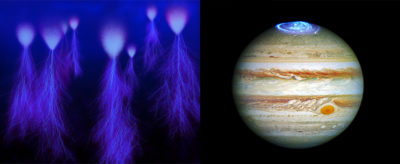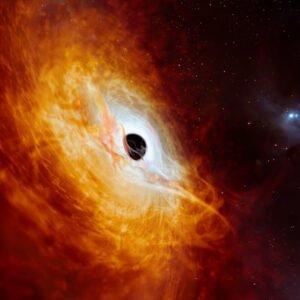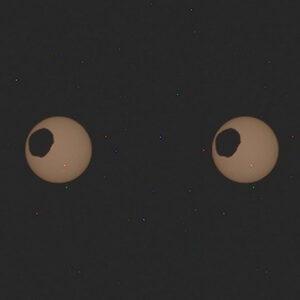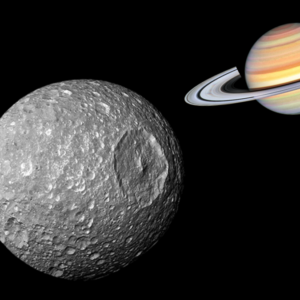
Space used to feel like it was part of the great unknown, but these days, it doesn’t quite feel that way anymore. Just recently, NASA’s Juno spacecraft managed to capture some incredibly high-definition images that show a bunch of vibrant lightning-like bursts of energy floating in the atmosphere of Jupiter, which is the largest planet in our solar system.
Looking at the images, the subjects in the photos look like jellyfish hanging in the sky which have been aptly called “sprites” along with glowing disks that have been named “elves.”
Although they may seem like brand new phenomena, they were actually discovered back in 1989, and are considered to be quite common, occurring in the upper portions of the Earth’s atmosphere during thunderstorms. And since being discovered over 30 years ago, they have actually been spotted in every single continent around the globe except for Antarctica.
According to the scientists and experts, they theorize that all planets with lightning should probably produce these super-fast electrical bursts that happen 60-miles up in the atmosphere. In fact, researchers even ascertained that these lightning-like bursts that reach toward space were probably already appearing in Jupiter’s colossal atmosphere. But they only got the evidence they needed to support these claims recently, all due to Juno. In fact, before these images were captured, no one had actually seen these luminous “dancing sprites” before.
It was only in 2016 when Juno was cast into space in order to orbit Jupiter, where the spacecraft managed to take an abundance of images of the planet’s aurorae using the spacecraft’s ultraviolet light, otherwise known as the ultraviolet spectrograph instrument (UVS). When the scientists began looking through the images and eventually processed them, that’s when they noticed the incredibly incandescent streaks of ultraviolent emissions that were making sensational flashes of light before hastily vanishing out of sight.
According to the publication Business Insider, while speaking at a press conference during the annual meeting of the American Astronomical Society’s Division for Planetary Sciences, Juno scientist Rohini Giles explained “In the process of putting together those images, we noticed that very occasionally we saw these surprising, short-lived, bright flashes.”
She went on to say, “We then went and searched through all of the data that we’ve taken over four years of the mission and we found a total of 11 flashes all with very similar properties.” Notably, the outbursts were said to have lasted for a few milliseconds only in the footage.
Then on October 27, Giles’s team also went on to publish a study on these new phenomena in the Journal of Geophysical Research: Planets entitled Possible Transient Luminous Events Observed in Jupiter’s Atmosphere.
Elves and sprites on Jupiter? It’s not those mythical creatures, but rather brief flashes of light in the gas giant’s upper atmosphere. Data from our #JunoMission indicate these transient luminous events could happen high above Jupiter’s water cloud layer. https://t.co/EXvNbnUc9d pic.twitter.com/sCw8XdAVGM
— NASA JPL (@NASAJPL) October 27, 2020
On earth, these sprites are said to resemble alienlike jellyfish-style creatures that happen to dangle from the ionosphere, which is the layer found right on top of the dense lower atmosphere. But in other cases, they can appear like standing pillars of light with narrow looking tentacles that dangle below them, which are often dubbed “carrot curls” because of their stark resemblance to the actual root vegetable.
The name “sprites” was chosen by the late Davis Sentman, a former physics professor at the University of Alaska. He chose the moniker because according to him, they were “well suited to describe their appearance” considering their “fleeing, fairy-like nature,” much like the impish folklore creatures the name comes from.
These actual scientific phenomena occur ‘when lightning strikes the ground, releasing positive electrical energy that requires balancing by an equal and oppositely charged electrical discharge into the sky.’ These sprites also happen much higher in the sky, more so than regular lightning which is said to occur in the middle of electronically charged air, clouds and the surface of the planet. But there are some cases where lightning strikes can also force electromagnetic pulses upward rather than downward, which then make “elves” which are otherwise described as glowing disks.
Giles also shared, “On Earth, sprites and elves appear reddish in color due their interaction with nitrogen in the upper atmosphere. But on Jupiter, the upper atmosphere mostly consists of hydrogen, so they would likely appear either blue or pink.”
Yet despite the discovery, the Juno team shares that they cannot confirm if the events were due to lightning strikes or not. The main reason why they can’t establish this is because the probe’s lightning detecting device happens to be on the opposite side of the spacecraft from the UVS. Secondly, the images that were captured by these two devices were taken 10 seconds apart, a period which is considered way too long for both devices to be able to analyze the same flash of light as they happen.
However, the research team is still convinced that all of the 11 detected outbursts ‘were transient luminous events.’ The scientists explained that there were many similar characteristics in every single one of them. These included emitting major bouts of hydrogen, disappearing quickly, and occurring 186 miles above Jupiter’s water clouds, which meant that they were way too high to be regular lightning. Giles iterated, “We’re continuing to look for more telltale signs of elves and sprites every time Juno does a science pass.”
She added, “Now that we know what we are looking for, it will be easier to find them at Jupiter and on other planets. And comparing sprites and elves from Jupiter with those here on Earth will help us better understand electrical activity in planetary atmospheres.” In the meantime, people can admire them for the luminescent beauty that they all hold.
What are your thoughts? Please comment below and share this news!
True Activist / Report a typo


